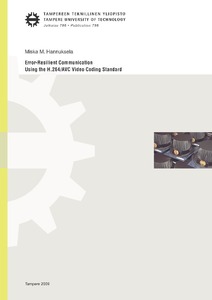Error-Resilient Communication Using the H.264/AVC Video Coding Standard
Hannuksela, Miska M. (2009)
Hannuksela, Miska M.
Tampere University of Technology
2009
Tieto- ja sähkötekniikan tiedekunta - Faculty of Computing and Electrical Engineering
This publication is copyrighted. You may download, display and print it for Your own personal use. Commercial use is prohibited.
Julkaisun pysyvä osoite on
https://urn.fi/URN:NBN:fi:tty-200903121043
https://urn.fi/URN:NBN:fi:tty-200903121043
Tiivistelmä
The Advanced Video Coding standard (H.264/AVC) has become a widely deployed coding technique used in numerous products and services. H.264/AVC utilizes predictive coding to achieve high compression ratio. However, predictive coding also makes H.264/AVC bitstreams vulnerable to transmission errors, as prediction incurs temporal and spatial propagation of the degradations caused by transmission errors. Due to the delay constraints of real-time video communication applications, transmission errors cannot usually be tackled by reliable communication protocols. Yet, most networks are susceptible to transmission errors. Consequently, error resilience techniques are needed to combat transmission errors in real-time H.264/AVC-based video communication. The thesis presents methods to improve the error robustness of H.264/AVC in real-time video communication applications. The presented methods can be grouped into three topics: isolated regions, sub-sequences and interleaved transmission, and encoder-assisted error concealment. In addition to improved error resilience, it is shown that the sub-sequence technique improves compression efficiency compared to non-hierarchical temporal scalability and non-scalable bitstreams. A part of the research work presented in this thesis was targeted at the H.264/AVC standard. Specifically, isolated regions, sub-sequences, and the presented encoder-assisted error concealment methods were adopted into H.264/AVC, and the interleaved transmission feature was included in the specification for real-time carriage of H.264/AVC bitstreams over the Internet Protocol.
Kokoelmat
- Väitöskirjat [4772]
